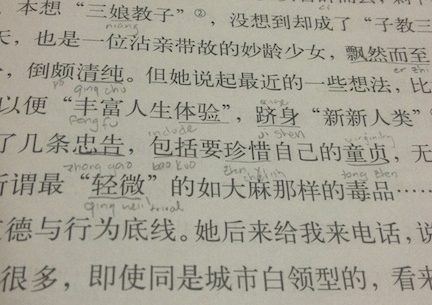My little hairdresser was looking at my Chinese textbook the other day, and noticed that I had written pinyin (or the alphabet version of the words pronunciation) under the Chinese characters so I could pronounce them.
“You know, I used to do this with my English homework,” he said.
“What, write pinyin?” I asked.
“No, use Chinese characters to help me remember the English words.”
In Chinese there are many words that mix English and Chinese. For instance a common way to say thank you is 三Q. 三 is pronounced san, plus Q sounds like san Q, or thank you. San means three so sometimes people just write QQQ (3 Q’s, get it).
But what Liu was telling me was different. As a kid, he actually wrote chinese characters underneath the English to remember the pronunciation. I asked for some examples.
For instance, to remember Hello, he would write the characters 哈楼 pronounced ha lou. Or for longer sentences, like Good Morning, he would write 古得摸你, pronounced gu ta mo ni.
I don’t know why, but I found this really hilarious and had him write down more examples. Can you guess this saying? 来撕特米凸U (English u), pronounced lai si te mi tu u.
Or this word? 康皮又特儿 pronounced kang pi you te er.
(Answers: Nice to meet you, and computer.)
I also asked if he could do it for any word and I just said a few English words and he figured out the Chinese words that equal the sound.
And while I know it’s not a perfect system (as proven by his terrible English pronunciation) I think it’s really creative. When I write the alphabetized spelling of a Chinese word I’m just following the prescribed way taught by textbooks. But when’s he’s doing it, he really thinks about the English word, thinks about the pronunciation and uses his brain to find a solution.



Leave a Reply